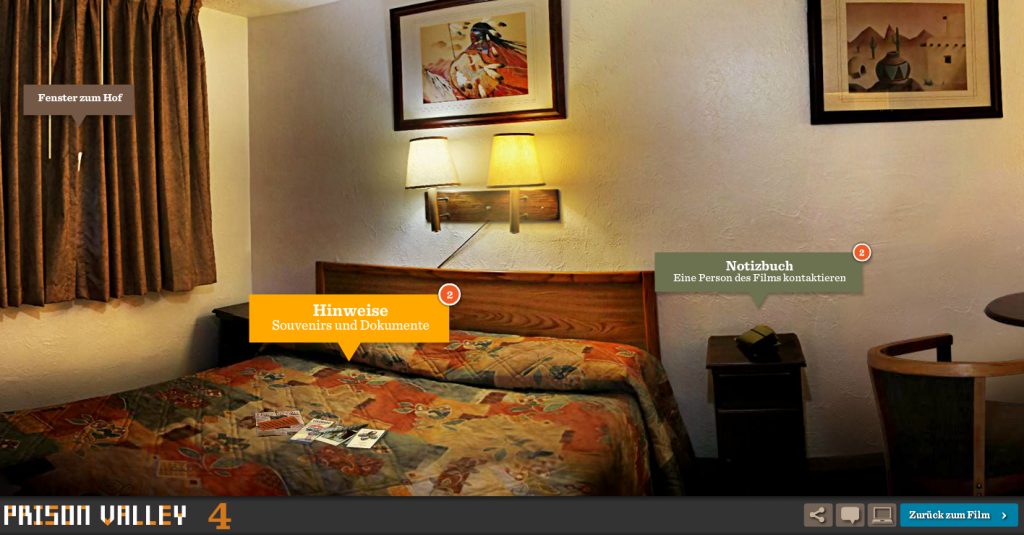Web Documentaries … What Are They?
 A whole generation of young authors and directors view interactive storytelling as a promising new way of expression. They also view them as a wonder drug that will lure in tomorrow’s viewers who have grown up with multimedia content.
A whole generation of young authors and directors view interactive storytelling as a promising new way of expression. They also view them as a wonder drug that will lure in tomorrow’s viewers who have grown up with multimedia content.
The fact is web documentaries are attracting ever-increasing audiences. But what exactly is a web documentary? In this guest blog post, video journalist, blogger and web documentary producer Philipp Barth takes us through the genre.
What is a web documentary?
Also known as a webdoc, interactive documentary, i-doc or multimedia documentary, having so many terms to chose from gives an idea of how difficult the web documentary is to define.
Basically, web documentaries are stories of documentary character published on the Internet. They can be put together in different ways, use different interfaces and have different approaches to their subject matter, but they have several features in common.
The viewer’s new role
Viewers of web documentaries aren’t simply just viewers anymore because they can choose from various options within the web documentary, thereby influencing how the story unfolds. As such, they are somewhere in between being viewers and authors and in between having a passive and a participatory role. They have to come to terms with this new role.
Multimedia
Web documentaries aren’t limited to any one form of expression. They are multimedia in the best possible sense and so everything is allowable: video, audio, slideshows, audio slideshows, text, infographics, maps, charts, illustrations and additional interviews.
New types of collaboration
With such a profusion of possible multimedia forms, web documentaries need to have a wealth of specialists working on them. This means web documentaries require collaboration; designers, graphic artists, photographers and programmers work alongside the directors and producers from the very beginning of the production process.
As the Canadian documentary maker Peter Wintonick says, a web documentary “is a kind of symphony, or at least a chamber music concerto with composers and conductors, and artists and audiences all playing important roles”.
Viewer participation
Most web documentaries incorporate some kind of viewer participation. At the very least, viewers have the possibility of joining in discussions, uploading their own photos, taking part in competitions or voting etc. In the ideal case, a web documentary can continue to be an active platform for certain topics or communities even years after its release.
Who actually makes web documentaries?
A whole row of veteran documentary makers and photographers are turning to the genre because it offers new ways of telling stories. It is also attracting young documentary makers who have grown up the possibilities of the Internet. In France, numerous journalism schools are already putting an emphasis on learning how to produce web documentaries; courses on interactive story-telling are booming.
How are web documentaries made?
Web documentaries differ from film documentaries in that they require enormous amounts of programming. For example, the French interactive production “Jour de Vote” required 12 days of filming and 20 days of programming. The programming is usually done by external specialists who craft the interactive world according to detailed instructions. This means the directors need to work out the concept down to the tiniest detail.
For those who don’t want to, or can’t afford to go to such an effort, web documentary tools such as Klynt, 3wdoc and Djehouti (in French) offer an easier way to create interactive documentaries.
How did the wed documentary genre develop?
The term was used for the first time in 2002 at the Cinema du Réel Festival held at the Centre Pompidou in Paris. The first production that could be called a web documentary by current standards was “La Cite des Morts” created in the 2005 by the Paris firm Upian.
Upian was also responsible for “Thanatorama“an investigation of what happens to your body after you die that takes the viewer to a funeral home, crematorium and cemetery. The web documentary, which is highly recommended viewing, starts by directly addressing the viewer; “You died this morning. Are you interested in what comes next?” (If you click on ‘No’ by the way, it takes you to Google’s homepage.)
In 2008, the French-German television channel Arte produced the online documentary project “Gaza Sderot“showing the experiences of people living on both sides of the Isreali-Gaza border. The border is a theme that repeats in all of the website’s pages and menu options.
In the same year, the French production company Honkytonk released “Voyage au Bout du Charbon” (Journey to the End of Coal) about the world of Chinese coal miners. The web documentary uses a structure similar to that of adventure games such as Monkey island; viewers navigate through a world and can decide for themselves where their journey will take them. This was the first time that a web documentary explicitly copied the look and structural logic of online games. Many other interactive documentary producers, including Deutsche Welle, now use this device.
The web documentary genre had its major breakthrough with “Prison Valley” in 2010. It was the first time an interactive project attracted a larger audience – “Prison Valley” had 600,000 visitors in the first eight months of its release, which back then was a record. The Arte production was won numerous prizes and is still considered a seminal work.
In 2011, the National Film Board of Canada released the productions “Welcome to Pine Point” (part-book, part-photo album and part-film) as well as “Bear 71″, a web documentary that sets the viewer free in interactive world without any set direction.
How much interactivity does a web documentary need?
Interestingly, many of the successful web documentaries have a relatively high degree of linear narration and don’t offer the viewer too many interactive possibilities. It is still a matter of contention whether interactivity is useful or not. The game designer Florent Maurin uses the term “information tsunami” to describe the fear of missing out on content when faced with too many options.
That can spell poison for the story because on computers, viewers attention spans are very slight. As soon as they are bored or confused, they are gone. Simon Bouisson, one of those responsible for “Jour de Vote“, sums up the problem.
“It is better that lazier viewers can understand the story with a just few clicks while more active viewers can play with the content and the story. But just because we are online doesn’t mean that we have to break the story up and make everything optional because viewers will then lose track.”
What direction are web documentaries taking?
The trend is to “less is more”. Even though it is possible to give viewers interactive choices, this doesn’t change the basic premise of storytelling – stories still have a beginning and an end.
Choices will be used more deliberately and linear elements will gain importance. (Although the German documentary film maker Florian Thalhof propagates the “end of linearity” at his Korsakow Institut.)
“Interactivity has to be reinterpreted every time,” says Alexander Knetig from Arte’s web production department. Arte is one of the biggest web documentary producers and an important platform for interactive formats. The broadcaster receives more than a hundred web documentary pitches each year but only seven or eight of them are realized. The latest is “Alma, a tale of violence” which had 100,000 hits just a few days after its release.
In “Alma“, interactivity means letting viewers decide if they will watch the video footage of Alma telling her story directly to the camera or if they will look at the accompanying photos and film footage while listening to Alma talk.
This is a very simple solution that isn’t far from a linear film narration. This relatively simple approach is also suitable for tablet users, who can intuitively navigate with their fingers.
In the future, no large-scale production will be able to do without an an app. Even if you ignore the new markets that increasing tablet sales will bring, the interactive possibilities offered by the touchscreen are too just attractive.
How are web documentaries financed?
Finding funding for interactive formats continues to be difficult and this is something that all web documentaries have in common. The complexity of the programming also makes production expensive and viewer numbers are still relatively small. You can’t make any money with web documentaries.
That is why web documentaries rely on “transmedia multiplication” and why the projects are often conceived for diverse range of media from the very beginning. The best example of this is “Alma“. As well as the web documentary, Arte also released a documentary film, a smartphone app and a book and also held an exhibition on the topic. It is assumed that the project is present in social networks.
What should I read and how do I keep myself up to date?
The book “Webdocs … a survival guide for online filmakers” is a great overview. It has interviews with some of the most important cross-media experts and also has practical tips about financing.
When and how does a good web documentary enthrall viewers and how much interactivity is necessary? Game designer Florent Maurin has some interesting thoughts on the topic.
Arnau Gifreu, a multimedia lecturer and producer of interactive content looks in detail in his article, “The Interactive Documentary. Definition, Proposal and Characterization of the New Emerging Genre.”
Here is a Twitter list with people worth following.
Philipp Barth is a video journalist and operates Webdoku, one of the most renowned German language sites on web documentaries. He is co-author of the webdoc “Yunnan Export” and currently doing a traineeship at Deutsche Welle.







Feedback